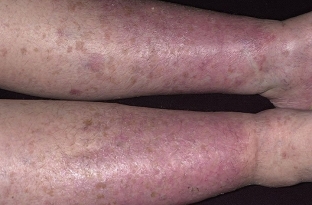Varicosis or varicose disease – This is a pathology known to almost everyone. Expansion of the vessels of the lower extremities with subsequent pathological processes occurs in a very large number of people, and often begins at a fairly young age – 30-40 years old. Varicose changes in blood vessels also affect the condition of the skin, therefore, varicose veins are also familiar to dermatologists. Today on estet-portal.com read about varicose dermatitis, its causes, characteristic symptoms and methods of preventing this disease.
Causes, symptoms and prevention of varicose dermatitis
Varicose dermatitis – this is a specific inflammatory process of the skin that occurs over varicose veins, the function of which is reduced or completely lost.
The trigger for the development of inflammation is the release of the liquid component of the blood through the thinned walls of the affected veins.
The disease is accompanied by such unpleasant symptoms as itching and flaking of the skin, and has a chronic course. The result of varicose dermatitis may be the appearance of trophic ulcers, which is why the pathology must be identified and eliminated in a timely manner.
Varicose dermatitis:
- causes and mechanism of development of varicose dermatitis;
- clinical picture of varicose dermatitis: characteristic symptoms;
- effective methods for preventing varicose dermatitis.
Causes and mechanism of development of varicose dermatitis
The main cause of varicose dermatitis is varicose veins, as well as thrombosis of venous vessels. Under the influence of many factors, as overweight, traumatic injuries of the lower extremities, diseases of the heart and kidneys, sedentary work, and so on, the work of the veins in the lower extremities is difficult, it becomes more and more difficult for them to push blood against the force of gravity, thinning of the muscle wall occurs. ; Dystrophy leads to local stagnation of blood, to which the body reacts by increasing the permeability of the venous wall and the release of the liquid part of the blood under the skin, which provokes the development of the inflammatory process.
Clinical presentation of varicose dermatitis: characteristic symptoms
The initial stage of varicose dermatitis is accompanied by the following symptoms:
- redness of the skin of the legs in the area of the shins and ankles;
- hardening of the skin on the affected areas;
- periodic itching on the lower extremities;
- appearance of small blisters containing a clear liquid, which disappear on their own.
In the future, the skin on the affected areas acquires a dark red hue, becomes more and more dense, itching intensifies, and nodules are felt under the skin. Bubbles with transparent contents appear in large numbers, and when they disappear, they leave crusts and peeling. In the absence of treatment – trophic ulcers appear on the inflamed areas, which quickly suppurate and can lead to very serious consequences.

Effective methods of prevention of varicose dermatitis
Prevention of the occurrence of varicose dermatitis implies, first of all, the prevention of the development of varicose veins of the legs. To do this, it is recommended to lead an active lifestyle, walk a lot, do physical education. A good preventive effect is provided by dousing the legs with a contrast shower, as well as foot massages. In addition, due consideration should be given to shoes that are comfortable, breathable and without high heels.
When the first signs of varicose veins appear, the patient should contact the appropriate specialist and undergo a course of treatment.
Estet-portal.com thanks you for your attention. Leave your feedback, wishes and comments in the comments to this article.









Add a comment